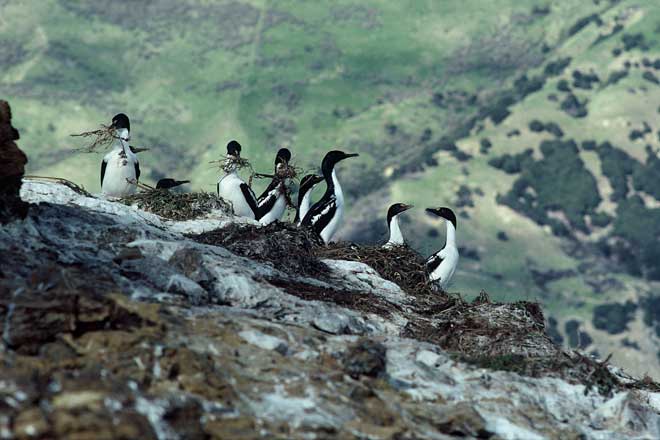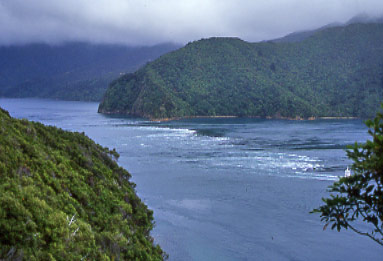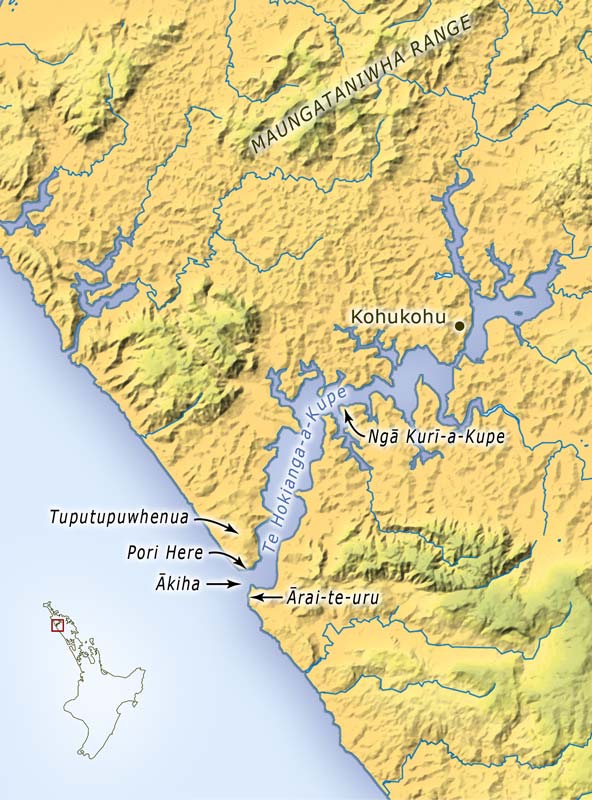

Ra'iātea, Society Islands, French Polynesia

"According to some tribal narratives, Kupe was the first Polynesian to discover the islands of New Zealand. His journey there was triggered by difficulties with fishing in Hawaiki, his homeland. Apparently the problem was a great octopus belonging to Kupe’s competitor, Muturangi. Kupe set out in his canoe to kill the octopus, and such was the length of the pursuit that it brought him to New Zealand. With a companion known as Ngake (or Ngahue) in another canoe called Tāwhirirangi, he pursued the creature all the way to Cook Strait (known as Raukawakawa), where it was finally destroyed.

Kupe’s locations
The arrival of Kupe is of great importance, and many tribes are at pains to cite a relationship to him. It is said that his wife, Kuramārōtini, devised the name of Ao-tea-roa (‘long white cloud’) on seeing the North Island for the first time. Like Māui before him, Kupe’s arrival is a foothold in the land for Māori. His adventures took place predominantly in the south Wairarapa, Cook Strait and Northland regions. However, in some versions he travelled as far south as Arahura on the South Island’s West Coast, and to the Coromandel Peninsula. Taputapu-ātea and Te Whitianga-o-Kupe, for example, commemorate Kupe’s time in Hauraki.
A Cook Strait story
As with many important traditions, there are several versions, particularly in the Cook Strait region and in the north. In an account narrated by a man named Te Whetu of Te Āti Awa to the ethnographer Elsdon Best, Kupe travels down the west coast from the Auckland region to Taranaki, and then to the Cook Strait region. Here his two birds, which he had brought from Hawaiki, set off to the South Island to survey the new lands. One, a cormorant named Te Kawau-a-Toru, becomes ensnared at Te Aumiti, a narrow stretch of water off Rangitoto ki te Tonga (D’Urville Island):
"Te Kawau-a-Toru proceeded … he put one of his wings into the water and the other was above but he did not have a sound footing … Friend! The wing broke … and Kupe’s champion perished."
The breaking of the wing formed the passage (now known as French Pass) through which vessels can sail, while the unharmed wing remains an obstruction. The rocky reef is known as Te Kawau-a-Toru.


Returning to Hawaiki
Stories of Kupe are also held in the north. In an account by Ngāpuhi elder Himiona Kāmira, describing Kupe’s return to Hawaiki from Hokianga,

"Time arrived for Kupe to return to Hawaiki … [He left] Tuputupu-whenua as a spring for Hokianga. On the morning of his departure, he took his son (Tuputupu-whenua) to the … spring … He bade farewell by saying, ‘Farewell, The Spring in the World of Light. I now return, I will never return.’ With Kupe’s farewells completed he despatched his son into the spring called The Spring in the World of Light. He instantly turned into a taniwha. This is the origin of the name ‘Hokianga’ – hoki means ‘to return’."

Kupe’s place names
Kupe named many localities including Arapāoa, Mana, the islands Matiu (Somes Island) and Mākaro in the Wellington region, Kohukohu, Pouahi, Maungataniwha and Hokianga in the north. These names have been preserved by generations of Māori people settling the regions. While some of the names from other ancestors have been lost, those associated with Kupe seem to have endured." (Royal, 2005).
"Though all the Whanganui natives say that Kupe only found the tiwaiwaka and tieke or kokako here – yet when questioned closely the old men admit the existence of tangata whenua in the valley of the Whanganui. These were the Nga paerangi, descendants of Paerangi-o-te-moungaroa, whose ancestors came from Hawaiki some 5 gens before Aotea [I], brought hither by his atua, he [Paerangi-o-te-moungaroa] had no canoe.", Paerangi o te Maungaroa was the descendant of the earlier tangata whenua, including Te Hă I, Mōuruuru, Whirotupua, and Houmea (Waitangi Tribunal, 2015a).
Whirotupua, Paerangi's ancestor, was Kupe's first cousin twice removed].
"When they arrived upon the ridge Mairehau, they observed smoke from the ancient fires of the descendants of Paerangi. They returned informing Kupe of what they saw, resulting in the tribal expression "the long burning occupation fires of Paerangi-i-te-wharetoka." (Whanganui Iwi & The Crown, 2014).
"...the explorer Kupe, his brother Nukutoea, ..." (Rangitāne o Wairarapa and Rangitāne o Tamaki Nui-ā-Rua et al., 2016).
"...Hine-i-te-aparangi, his [Kupe's] wife, ...Hine-te-ura, Kupe’s daughter... ... stretched forth her hand into the water to get a stone as a sinker for the bottom of the net, the one she got was quite different from any she had seen before, and so it was called inanga." (Whatahoro & Smith, 2015).
Sources
Folksong. (n.d.). Waiouru history: Settlers from Polynesia.
https://folksong.org.nz/waiouru_history/7_polynesia/index.html
Jubilee: Te Tiupiri. (1898, April 26). Meiha Keepa Rangihiwinui: He tino kaumatua rangatira no te iwi Maori o Niu Tireni.
https://paperspast.natlib.govt.nz/newspapers/JUBIL18980426.2.4?end_...
Rangitāne o Wairarapa., & Rangitāne o Tamaki Nui-ā-Rua. (2013, June 13). Rangitāne Settlement Negotiations Trust [Hui summary paper].
https://tumaira.nz/wp-content/uploads/2021/04/6.1-Coastal-Interests...
Rangitāne o Wairarapa and Rangitāne o Tamaki Nui-ā-Rua., The Trustees of the Rangitāne Tū Mai Rā Trust., & The Crown. (2016, August 6). Deed of settlement of historical claims [Deed]. New Zealand Government.
https://www.govt.nz/assets/Documents/OTS/Rangitane-o-Wairarapa-and-...
Royal, T. C. (2005, February 8). First peoples in Māori tradition - Kupe. Te Ara Encyclopedia of New Zealand.
https://teara.govt.nz/en/first-peoples-in-maori-tradition/page-6
Smith, S. P. (1899). Hawaiki: the whence of the Maori, being an introduction to Rarotongan history: Part III. The Journal of the Polynesian Society 8(1), 1-48.
https://www.jps.auckland.ac.nz/document/Volume_8_1899/Volume_8,_No....
Waitangi Tribunal. (2015a). He whiritaunoka: the Whanganui land report. Legislation Direct, Government of New Zealand.
https://forms.justice.govt.nz/search/Documents/WT/wt_DOC_97551683/H...
Waitangi Tribunal. (2015b). Document D42 (Hāwira), p 4. In He whiritaunoka: the Whanganui land report, 903. New Zealand Ministry of Justice.
Whanganui Iwi., & The Crown. (2015, August 5). Ruruku whakatupua te mana o te iwi o Whanganui [Report]. New Zealand Government.
https://www.govt.nz/assets/Documents/OTS/Whanganui-Iwi/Whanganui-Ri...
Whatahoro, H. T., & Smith, P. S. (2015, November 15 [1913]). Kupe [Te Matorohanga]. Rangitāne Education [Journal of the Polynesian Society 4. 118-133].
https://rangitaneeducation.com/kupe/
| 661 |
661
|
||
| ???? | |||
| ???? | |||
| ???? | |||
| ???? | |||
| ???? | |||
| ???? |
French Polynesia
|
||
| ???? | |||
| ???? | |||
| ???? |